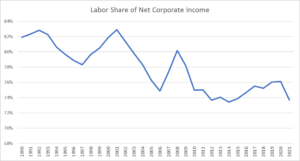April 13, 2022
A popular line on our recent surge of inflation is that an over-tight labor market has led to rapid wage growth, which in turn is forcing companies to raise prices. Higher prices will lead workers to demand higher wages, which will give us a wage-price spiral and soon lead to double-digit inflation.
While this was a story that plausibly fit the data in the 1970s, it is very hard to make the wage-price spiral fit the current situation for a simple reason: the wage share of income has fallen sharply since the pandemic.
Here’s the picture.

Source: Bureau of Economic Analysis.
As can be seen, the wage share of corporate income had been recovering gradually from the troughs it hit following the Great Recession in 2014.[1] However, we see a sharp reversal in 2021, with the wage share falling from 76.1 percent to 73.7 percent, a decline of 2.4 percentage points.
Perhaps some economists can tell a story where rapid wage growth is driving inflation even as the wage share of income is falling, but I’m not that good an economist. This still looks to me like a case where supply-side disruptions, associated with the reopening from the pandemic and the war in Ukraine are driving inflation.
This view is consistent with the fact that year-over-year inflation in the European Union was 7.5 percent as of March. The EU countries did not have as big a stimulus as the United States and by most measures its labor market is not as tight.
[1] Wage share actually refers to all labor compensation, Line 4, NIPA Table 1.14. Corporate income is the sum of labor compensation and net operating surplus (Line 8).







Comments